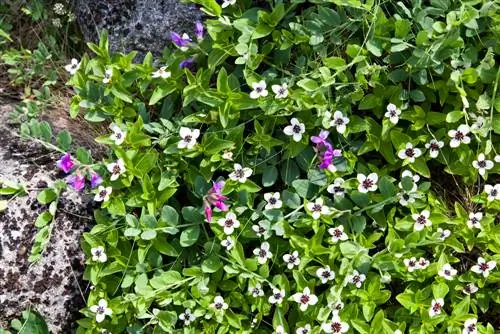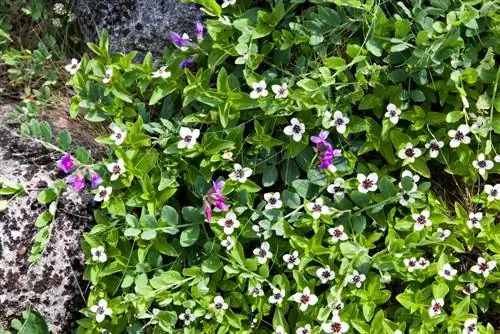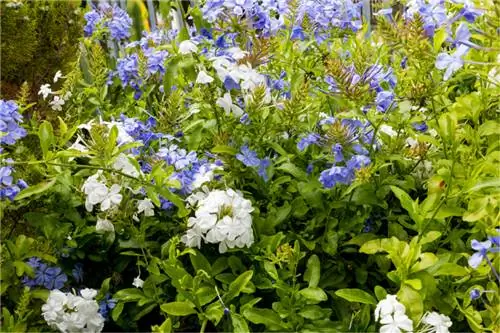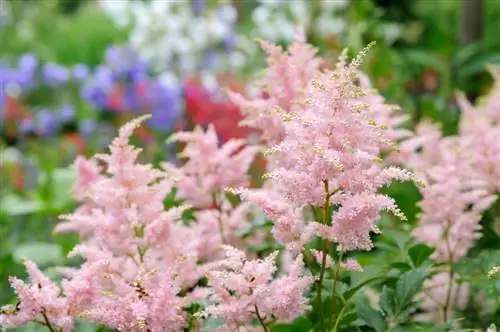- Author admin [email protected].
- Public 2023-12-25 17:45.
- Last modified 2025-01-23 11:21.
Flower dogwood delights the eye with colors and shapes from spring to late autumn. When the growing season begins for the trees, they beautify the garden with a striking display of flowers. In autumn the foliage develops intense red tones.

What is a flower dogwood?
Flowering dogwoods are ornamental trees with showy flowers that are used in many gardens as solitary plants or in arrangements with other plants. They come from North America and Asia and offer colors and shapes from spring to late autumn.
Origin
Various species from the dogwood genus, which has the Latin name Cornus, are known in German as flower dogwood. This group includes woody plants that develop showy flowers with white or light red colors. Their distribution area extends across North America and East Asia. They grow on fresh soil in the understory or in the edge areas of deciduous and coniferous forests.
leaves
The leaves are arranged oppositely. Two leaves sit opposite each other on the branch. They are divided into leaf blades and stems. The blade is simply designed and has the entire edge. It grows between seven and twelve centimeters long and is oval-shaped. The striking leaf venation is typical for all dogwood species. Lateral nerves branch off from a raised midrib on both sides and run curved to the tip of the leaf.
When dogwood flowers sprout, the young leaves appear yellowish to green. Over the course of the growing season they change their color to a dull green. In autumn the leaves turn orange-red to purple. They fall from the branch shortly before the onset of winter and decompose comparatively quickly.
Bloom
The flowers appear shortly before or when the leaves emerge. Around 20 individual flowers are clustered together to form small spherical to umbel-shaped inflorescences. It is not the petals that are decoratively colored in white or pinkish red. The inconspicuous flowers are surrounded by strikingly large bracts, which take on the function of petals due to their coloring. They serve to attract insects as potential pollinators.
The buds are formed in autumn. They are between five and ten centimeters long and indented at their tip. After they unfold in spring, the bracts are connected to each other at their tips. Only later do they separate from each other and stand free. Depending on the species and variety, the buds open between the end of April and the end of June. Young dogwood flowers are not yet in full bloom. It takes a few years for the bracts to reach their final size.
Growth
Flowering dogwoods grow as shrubs with multiple trunks or as a small tree with a main trunk and crown. They grow between four and seven meters high. In individual cases the species can reach heights of up to twelve meters. If crowns are developed, they appear in a broad to rounded shape. The side branches grow almost horizontally. Young branches have greenish bark that turns reddish when exposed to sunlight. With age, the branches turn gray and tend to crack.
The trees have shallow roots. They develop a creeping root system close to the soil surface. The roots react sensitively to soil compaction, injuries and flooding.
Usage
Cornus species are popular ornamental trees that are planted in individual positions. The tree-like growing representatives need a lot of space so that they can spread their expressive crown unhindered. The shrub-shaped representatives are suitable for planting arrangements with other species. They harmonize with red Japanese maple species or witch hazels, which develop yellow flowers. Flower dogwoods can be combined with topiaries. They loosen up the overall picture so that it appears less severe.
Flowering dogwoods can be combined with various perennials. They look good in the background of perennial plantings. Late bloomers such as autumn anemones, silver candles or monkshood provide color contrasts.
Here the trees set accents:
- in the bucket on the balcony
- in courtyards and front gardens
- in house entrances and driveways
Edible
The fruits of the flower dogwood are not poisonous. Most species develop red berries that have a bland taste. They consist of a thick shell and have comparatively little pulp. Cornus kousa 'Teutonia' develops thick berries with a fruity taste. They are ready to harvest as soon as they have turned completely red and are slightly soft.
Which location is suitable?
Flower dogwoods grow in a well-drained and loose substrate. They prefer a sheltered location in a sunny location and like high humidity. Different species tolerate calcareous or clayey soils differently. The North American species require sandy soil with a pH value in the acidic or slightly acidic range. East Asian species also grow on loamy or slightly calcareous soils.read more
What soil does the plant need?
The soil should be rich in humus. Humid conditions are ideal, but waterlogging should not occur. Gravel drainage ensures that the water can seep away easily. The Asian species and varieties are less demanding on soil conditions.
The root zone likes cool and moist soil. Plant the tree disc with weak-growing ground cover plants. They help maintain the moisture conditions of the substrate at a constant level. Alternatively, you can mulch the soil or cover it with a layer of bark compost.
What is the best time to plant?
Planting in autumn is possible. However, young plants have little time to develop a strong root system before winter. Spring is better for planting. Wait for the last late frosts.
The correct planting distance
For tree-like flower dogwoods, make sure that no other trees interfere with the crown development. These species should better be settled in isolation in the open area. Shrub-like representatives can be placed in planting arrangements. Here you have to pay attention to the growth width of the respective species so that the plants are not too close together later.
You have to take this into account when planting:
- Root ball should be above ground level
- do not carry out any digging work in the area of the tree disk
- Thoroughly loosen the soil
Propagate flower dogwoods
Flower dogwoods can be propagated from seeds. The first fruits are developed from the age of five or six. Pick the ripe fruits and remove the pulp from the core. Place the seeds in a pot filled with potting soil (€6.00 on Amazon). Place the planter in a semi-shady place and keep the substrate evenly moist.
After the plant has grown to about 20 centimeters high, it can be planted outside. Accustom the plant to the outdoor conditions by placing the pot outside. There should be no more frosts as they damage the young plant.
In spring you can divide bushes and get daughter plants. These plants can be grown in containers or planted immediately in the garden. Since this method robs the mother plant of energy, it should only be carried out rarely.read more
Flower dogwood in pot
Flower dogwood species are suitable for cultivation in pots. Container trees do not grow as tall as their outdoor counterparts. If they are provided with a sufficiently large planter, they will quickly adapt to the conditions. A pot with a volume of between 30 and 50 liters is ideal. Fill the planter with a loose mixture of garden soil and coconut fiber. An optimal supply of water and nutrients is necessary so that the tree does not wither. In winter, make sure there is adequate protection from frost, as the roots in the pot can freeze very easily.
Place the pot in a bright location where sunny hours alternate with periods of shade. Flower dogwoods provide an aesthetic change on the balcony.
Cut flower dogwood correctly
Flower dogwoods rarely need to be cut. If the bush has become too tall or is affecting neighboring plants, thinning makes sense. Pruning ensures that older specimens are brought back into shape.
Wait until the last flowers have withered before cutting. Later pruning measures can affect bud development in autumn. Avoid a radical cut. It is better to thin out the crown. Cut off the outer shoots at their base that disturb the overall look.
The hybrid 'Venus' hardly forms any branches. In order to promote dense growth, targeted pruning of this variety in spring is recommended. Older plants also tolerate such pruning measures well.read more
Watering flower dogwoods
Flower dogwoods prefer balanced moisture conditions in the substrate. Prolonged drought causes just as much damage to trees as waterlogging. Water the plants regularly. If they grow in sunny locations, the water requirement increases. Use rainwater or very soft tap water, as many species cannot tolerate lime.
A layer of mulch on the ground ensures that the substrate remains evenly moist. The mulch also provides the plants with additional nutrients.
Fertilize flower dogwood properly
The species do not require additional fertilizer if the soil is mulched regularly. If plant growth stagnates, it makes sense to add nutrients. Provide the wood with manure or compost. You should not use liquid fertilizer as there is a risk of over-fertilization. Nutrient concentrations that are too high endanger plants even more than undersupply.
How do I transplant correctly?
If the flower dogwood needs to be moved, you should wait until the leaves fall in autumn. The tree is then in a resting state. Since the plants react sensitively to radical pruning, you should not prune flower dogwoods before transplanting.
Cut off a large ball and push sturdy boards under the roots to lift them out of the hole. This measure is well suited to loamy soils, as the root ball develops a compact clump with the soil. Loose substrate crumbles. If your flower dogwood grows in sandy soil, you should lift the tree slightly and put a thick plastic film under the root ball. You can then tie the film together at the base of the trunk to lift the root system and the surrounding soil out of the hole.
The new location should be prepared so that you can plant the tree quickly. Make sure to water regularly in the first year so that the roots can grow well in the new location.
Diseases
The American dogwood is particularly susceptible to anthracnose, also known as leaf tan. This fungal infection spreads among trees that are in locations that are too moist. It manifests itself as small spots on the leaves. If it spreads a lot, the leaves die, but the bush does not shed them immediately. If the fungus spreads extensively, the entire plant can die. The Asian dogwood is largely resistant to this disease. When buying, pay attention to the vitality of the plant and avoid trees whose leaves are spotted.
Infestation by powdery mildew can occur. This fungus leaves a white coating on the top of the leaves that can be easily wiped off. Its spores spread in warm and dry conditions. If powdery mildew is not controlled, leaves and flowers can die.read more
Pests
Occasional pests include the juniper leaf miner. If the tree is affected, its shoot tips turn brown. Remove the shoots in a timely manner. In Central Europe, the American flower dogwood is often colonized by the white-berry medlar. It is semi-parasitic and uses its roots to extract water and nutrients from the shoot axis of the flower dogwood.
Flower dogwood does not bloom
It takes several years for dogwoods to bloom for the first time. Five or more years can pass before the first flowers develop. An unsuitable location or incorrect care measures can also lead to the trees not blooming. If the summer months are too cold and very cloudy, flower dogwoods avoid developing their flowers. They require warm and sunny conditions and an optimal water supply.
First aid measures:
- watering thoroughly
- Check pH value
- fertilize
- Check he alth status
Brown leaves
If the flower dogwood turns brown leaves in late summer, insufficient water supply may be the cause. The need for water increases, especially in the hot summer months, and the tree needs to be watered daily. Depending on the soil type, the amount of water you need to give the plants will decrease or increase. Sandy soils should be watered more frequently, while clay soils hold water longer.
Tip
The tier-like growth of the dogwood flowers doesn't just look aesthetic. The growth habit proves to be a perfect shade provider. The tree-like representatives in particular can create small, cozy places in the garden as solitary plants. A bench directly in front of the wood invites you to linger from spring to autumn.
Varieties
- American Dogwood: Slow growing. Bracts white, flowering time between May and June. Growth height between 400 and 600 centimeters.
- Pacific flower dogwood: Suitable for mild winter regions. Bracts white, flowering time between May and June. Growth height between 300 and 600 centimeters.
- Japanese flower dogwood: white bracts with greenish-yellow flowers, flowering period between May and June. Growth height between 300 and 600 centimeters.
- Chinese flower dogwood: drought tolerant. Flowers white, blooms between June and July. Growth height between 500 and 800 centimeters.
- Venus: Hybrid of Japanese and Pacific dogwood. Robust, easy to grow. Flowers creamy white, bracts up to 15 centimeters in diameter.
- Cherokee Chief: Variety of American flower dogwood. Hardy. Bracts intensely pink in color.
- Cloud Nine‚: Variety of American flower dogwood. Hardy. Bracts white in color, richly flowered.
- Rubra: Variety of American flower dogwood. Does not tolerate waterlogging or lime. Bracts colored in shades of red with variable intensity.
- Eddie’s White Wonder: Variety of American flower dogwood. Blooms reliably with white bracts, flowering time in May.






